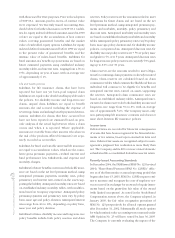American Express 2004 Annual Report Download - page 93
Download and view the complete annual report
Please find page 93 of the 2004 American Express annual report below. You can navigate through the pages in the report by either clicking on the pages listed below, or by using the keyword search tool below to find specific information within the annual report.
revised rule on the Company’s results of operations and
financial position. SFAS No. 123(R) also requires the ben-
efits of tax deductions in excess of recognized compen-
sation cost to be reported as a financing cash flow, rather
than as an operating cash flow as required under current
literature. This requirement will reduce net operating
cash flows and increase net financing cash flows in peri-
ods after the effective date.
In December 2004, the FASB issued FASB Staff Position
FAS 109-2, “Accounting and Disclosure Guidance for
the Foreign Earnings Repatriation Provision within the
American Jobs Creation Act of 2004 (the Act)” (FSP FAS
109-2) to allow additional time beyond the financial
reporting period of enactment to evaluate the effect of
the Act on the Company’s plan for reinvestment or
repatriation of foreign earnings for purposes of calcu-
lating the income tax provision. See Note 17 for further
discussion of the Act, including the status of the Com-
pany’s evaluation of the Act.
In October 2004, the FASB ratified Emerging Issues
Task Force (EITF) Issue 04-08, “The Effect of Contin-
gently Convertible Instruments on Diluted Earnings
per Share” (EITF 04-08). Certain debt instruments,
commonly referred to as “Co-Cos”, are contingently
convertible into the common share of the issuer after
the common share price has exceeded a predeter-
mined threshold for a specified period of time. Under
the EITF guidance, Co-Cos must be included in diluted
earnings per share calculations regardless of whether
or not the contingency threshold has been met.
As of December 31, 2004, the Company has $2 billion
principal outstanding of 1.85% Convertible Senior
Debentures due 2033 (the Debentures) with a current
base conversion price of $69.41 and a contingent con-
version threshold of $86.76 per share. Prior to the third
quarterof2004,theseDebentureswerecontingentlycon-
vertible into cash or common shares of the Company,
at the Company’s option. During the third quarter of
2004, in response to the issuance of EITF 04-08, the
Company notified the trustee and holders of the Deben-
tures that the Company was exercising its election stipu-
lated in the Debentures that, upon conversion of the
Debentures at any time after the date of such notice, the
Company will be required to deliver cash in an amount
at least equal to the accreted principal amount of the
Debentures converted. As a result of this election, the
Company will also be required to deliver only cash in
connection with any principal value conversion pursu-
ant to the trading price condition. The Company may
not revoke this election without the consent of holders
of at least a majority of the original principal amount of
the Debentures. See Note 7 for further information
regarding the terms of the Debentures.
As a result of this election, in accordance with EITF
04-08, there will be no impact on the future dilutive
earnings per share calculation related to these Deben-
tures unless the Company’s common share price
exceeds the base conversion price. In that scenario, the
Company would reflect the additional common shares
in the calculation of diluted earnings per share using
the treasury share method. See Note 8 for further infor-
mation regarding common and preferred shares.
In May 2004, the FASB issued FASB Staff Position FAS
106-2, “Accounting and Disclosure Requirements Related
to the Medicare Prescription Drug, Improvement and
Modernization Act of 2003” (FSP FAS 106-2). The Com-
pany elected to early adopt the provisions of FSP FAS
106-2 on a prospective basis as of April 1, 2004. As the
annual measurement date for the postretirement benefit
plans is September 30, the Company’s postretirement
benefit obligation was remeasured as of January 1, 2004
giving effect to the actuarially equivalent subsidy benefits.
The expected subsidy had the effect of reducing the Com-
pany’s accumulated postretirement benefit obligation
(APBO) by $29 million, which was recognized as a reduc-
tion in the unrecognized net actuarial loss. The unrecog-
nized net gain or loss outside a corridor equal to 10% of
the APBO is amortized over the average remaining ser-
vice life of the Company’s employees eligible for postre-
tirement benefits. The expected subsidy also affects the
service and interest cost of the plan, and reduced net peri-
odic postretirement benefit expense for the second quar-
ter 2004 by approximately $1 million. The expense
amounts shown in Note 16 reflect the effects of the early
adoption of FSP FAS 106-2.
Effective January 1, 2004, the Company adopted
SOP 03-1. SOP 03-1 provides guidance on: (i) the classi-
fication and valuation of long-duration contract liabilities;
(ii) the accounting for sales inducements; and (iii) sepa-
rate account presentation and valuation. The adoption of
SOP 03-1 as of January 1, 2004 resulted in a cumulative
effect of accounting change that reduced first quarter
2004 results by $71 million ($109 million pretax). The
cumulative effect of accounting change consisted of: (i)
$43 million pretax from establishing additional liabilities
for certain variable annuity guaranteed benefits ($33
million) and from considering these liabilities in valuing
DAC and deferred sales inducement costs associated
with those contracts ($10 million) and (ii) $66 million
pretax from establishing additional liabilities for certain
AXP
AR.04
91
Notes to Consolidated Financial Statements
























